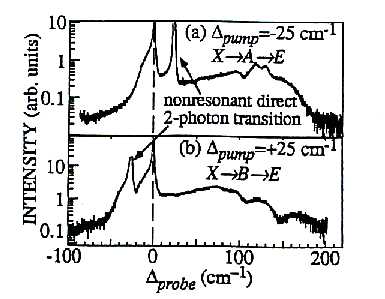 Figure 1. Wave packets moving on the a
state surface generated by the non-adiabatic B → a
a transition of the Hg-CO vdW complex.
Figure 1. Wave packets moving on the a
state surface generated by the non-adiabatic B → a
a transition of the Hg-CO vdW complex.International Workshop on Atomic Interactions in Laser Fields - Abstracts
Yukinori Sato, Kazuhiro Amano and Kenji Ohmori
Research Institute for Scientific Measurements, Tohoku University, 2-1-1 Katahira, Aoba-ku, Sendai, 980-8577, Japan
We present here two different laser pump/probe approaches to the mercury atoms interacting with the atoms (Ar) or the molecules (CO): One is a time-domain approach by means of ultrafast pump/probe techniques applied to the Hg-CO van der Waals (vdW) complex, and the other is a frequency-domain approach to the hot Hg-Ar quasimolecules by means of nanosecond-pulsed lasers for observing what we call the "second-order optical collisions".
First, ultrafast pump/probe measurements have been made to explore dynamics of the Hg(3P1)-CO half collisions that could never been extracted in frequency-domain.
Ultrashort pump and probe laser pulses (200 fs in pulse duration) were introduced collinearly into a vacuum chamber to intersect a supersonic beam carrying the Hg-CO (X 10+) vdW complex. The complex was excited by the pump pulse to the A 30+ or B 31 state to generate a wave packet moving on the excited state surface which correlated adiabatically to the asymptote Hg(3P1) + CO. Every time it reaches a particular point of nonadiabatic transition, a fraction is shared to the a 30- state surface and moves towards the asymptote Hg(3P0) + CO. The resulting Hg(3P0) atom was excited to the 7 3D1 state by the probe pulse to induce fluorescence for the LIF detection of the Hg(3P0). Scanning the pump-probe delay time, we have observed the Hg(3P0) population rising with a time constant of 19 ps.
While keeping the pump wavelength on the B-X band, the center of the probe wavelength was shifted by 10 cm-1 shorter from the atomic 7 3D1 - 6 3P0 transition. Then we observed beating LIF signals as shown in Fig.1. The period of the beat is 1.3 ps, which is attributable to the period of stretching vibration of the Hg-CO vdW mode in the B 31 state.
 Figure 1. Wave packets moving on the a
state surface generated by the non-adiabatic B → a
a transition of the Hg-CO vdW complex.
Figure 1. Wave packets moving on the a
state surface generated by the non-adiabatic B → a
a transition of the Hg-CO vdW complex.
The amplitude of the beat decays with almost the same time-constant with the one observed in the rise of the Hg(3P0) population. This means that the beating signal is due to a train of wave packets propagating on the a state surface and the B → a non-adiabatic transition occurs at a localized point near the closest approach of the Hg-CO encounter on the B state surface. We are now trying to apply this ultra-short pulse technique to the far-wing approach on the Hg-CO thermal collisions.
Second, we have observed the processes we call the "second-order optical collisions (SOOC)" where two-color, two-photon absorption takes place during a single encounter of Hg with Ar. For the thermal (~370 K) collision energies, those two photons need to be absorbed sequentially in a few picoseconds since a single collision is completed in this time scale. We have observed these ultrafast events using nanosecond laser pulses. Briefly, pump and probe pulses were simultaneously introduced into a heat-pipe oven containing the Hg vapor at a temperature of 370 K and the Ar gas at a pressure of 5.5 Torr. The pulse duration was about 6 ns for both pulses. The pump wavenumber was shifted from the Hg Hg 6 1S0 - 6 3P1 resonance line giving the A - X or B - X excitation of the Hg-Ar quasimolecule. The probe wavelength was scanned in the vicinity of the 6 3P1 - 7 3S1 resonance line to induce the E ← A or E ← B excitation. The fluorescence from the Hg(7 3S1) state produced by dissociation on the E state was detected.
The X → A → E and X → B → E SOOC spectra are plotted in Fig. 2 against the detuning |Δprobe| of the probe laser from the 6 3P1 - 7 3S1 resonance line. The resonances seen at |Δprobe| = 25 are ascribed to the E - X direct two-photon transition, which will not be discussed here. As is seen in Fig. 2, the SOOC spectrum changes depending on whether the intermediate state is the A or B state. The spectra display far-wing-line shapes for the E ← A and E ← B excitations of Hg-Ar. The structures on the blue side may be attributed to the double-well structure of the E state potential.
Based on a knowledge of the related potential energy curves, one can locate the Condon points corresponding to the pump and probe excitations. The time difference between the two successive excitations, which could be in picoseconds or even in subpicoseconds, can be changed by changing the wavelengths of the pump and/or probe lasers. These considerations suggest that one can carry out ultrafast pump/control experiments with subpicosecond time resolution using the nanosecond-pulsed lasers.
 Figure 2. Second-order optical collision
spectra of Hg-Ar. |Δpump|
and |Δprobe| are the
detunings of the pump and probe lasers from the Hg 6 1S0
- 6 3P1 and 6 3P1 - 7
3S1, resonance lines, respectively. T = 373
K.
Figure 2. Second-order optical collision
spectra of Hg-Ar. |Δpump|
and |Δprobe| are the
detunings of the pump and probe lasers from the Hg 6 1S0
- 6 3P1 and 6 3P1 - 7
3S1, resonance lines, respectively. T = 373
K.